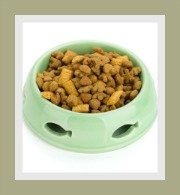About Feline Tapeworms
Signs, Treatment and Life Cycle
Feline tapeworms are one of a number of endoparasites (internal parasites) that live in your cat's intestines.
Endoparasites (in this case intestinal parasitic worms) are described as organisms that live and reproduce in the gut where they feed and derive their nourishment.
The most common feline intestinal parasites are tapeworms, feline roundworms, lung worms and a protozoan parasite called toxoplasma gondii.
types of cat tapeworms
There are 3 types of cat tapeworms that belong to the group of intestinal parasites known as cestodes:
- Diphyllobothrium Latum
- Dipylidium Caninum
- Taenia Taeniaformis
1. diphyllobothrium latum
This tapeworm is less common than Taenia and Dipylidium. This is a very long tapeworm and it is normally acquired via your cat hunting and eating or being fed undercooked or raw fresh-water fish.
2. dipylidium caninum
This is the most common cat tape worm and it thrives in the intestine of your cat.
Humans can be infected by this nasty little intestinal parasite.
As
the name implies, the tapeworm is long, anywhere from 8 inches (20 cm)
to 20 inches (50 cm). The worm is white and flat and consists of many
segments.
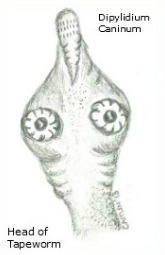
The tapeworm has a pointed, small head which it uses to attach itself to the wall of the intestine. The body as mentioned consists of flattened segments which contain maturing eggs.
You will seldom see intact feline tapeworms in the cat's feces. The reason
for this is that as the segments mature, segments break off the end of
the tapeworm and are expelled via the anus.
What is generally
observed in the stool are individual segments that resemble cucumber
seeds.
These fresh segments can be seen crawling across the feces or the cat's coat.
When the segments dry, they look a lot like grains of rice and these may be seen on the cat's fur (around the anus) or even on the cat's bedding.
The dry 'rice-like' segment then bursts open and releases the eggs into the environment.
life cycle of dipylidium caninum
Dipylidium caninum requires an intermediate host to complete its life cycle.
The dreaded cat flea (or sometimes lice) acts as the host.
Tapeworm eggs that are found on carpets, bedding or in the environment are consumed by flea larvae.
Once these eggs are eaten, they hatch inside the fleas intestines and then tunnel through the intestine into the flea's body where they form into cysts.
When the flea matures, it will seek an animal (your cat) to suck blood from.
Fleas create an irritation on your cat's skin and this causes your cat to scratch nibble and lick their fur, thereby ingesting the flea.
During digestion, the tapeworm cysts are released and develop into feline tapeworms. This cycle will continue.
Dipylidium caninum, if not controlled, can exist in large numbers in the intestines and can cause serious health problems in your cat.
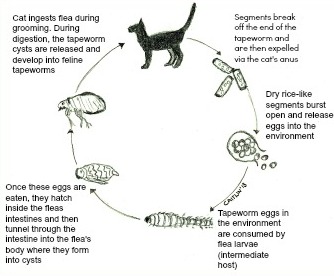
3. taenia taeniaformis
The taenia taeniaformis tapeworm is much longer - about 12 inches (30 cm) but can grow up to a meter in length.
It is also much larger and more corpulent (stouter) than the dipylidium caninum tapeworm.
This
tapeworm is less common than dipylidium but also requires and
intermediate host to complete its life cycle.
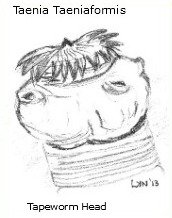
This cat tape worm cannot be transmitted to man. Kittens are unlikely to be infected by this tapeworm as kittens generally do not hunt for or eat prey.
In the case of taenia taeniaformis the intermediate hosts are normally small rodents
such as voles, rats or mice. The rodent ingests tapeworm eggs that are
present in the environment.
Cysts then form on the liver of the rodent and remain dormant until some unsuspecting free-roaming cat catches and consumes the rodent.
The cysts then release tapeworms which attach to
the lining of the cat's intestines where it derives nutrients before
shedding mature, egg-laden segments.
signs and symptoms of feline tapeworms
Generally speaking your cat will not display any symptoms. If
your cat is heavily infected by cat tapeworms you can expect to see the
following:
- Diarrhea and or vomiting
- Abdominal pain
- General lethargy (lack of energy) and lack of appetite
- Dull coat
- Anal irritation and consequently excessive licking (grooming) of the anal area.
- The presence of white segments in the feces or rice-like segments wriggling on the coat, around the anus or on bedding.
Cat worm symptoms must be taken seriously due the serious impact it has on your cat or kitten's health and the health of your family.
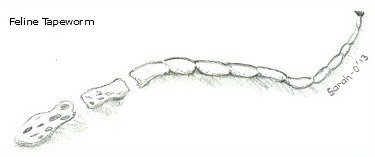
treatment of feline tapeworms
We always strongly recommend that you consult your veterinarian about the prevention and treatment of feline tapeworms.
Your vet will provide
the correct diagnosis, advice on the correct de-wormer to use and
prescribe the correct dosage.
Note:
Whilst you can purchase de-worming remedies without a veterinary
prescription, you need to be sure that you are using the correct
medication for the relevant intestinal parasite.
Cat and dog de-wormers
are different and not interchangeable and similarly, human worming
remedies should not be given to your pets.
You should start de-worming your kitten at around 6 weeks
and every 3 weeks thereafter until your kitten is 4 months old.
It is
generally recommended that you de-worm your cat every 3 - 4 months.
| Active Ingredient | Trade Name + Company |
| Praziquantel, pyrantel pamoate | Drontal Cat Tablets (Bayer) |
| Milbemycin and Praziquantel | Milbemax (Novartis) |
| Praziquantel | Droncit Feline Tablets (Bayer) |
| Emodepside and Praziquantel | Profender Topical Solution (Bayer) |
controlling fleas on your cat
Apart from de-worming your cat, you MUST control fleas, lice and rodents to avoid re-infestation.
The
safest way to control fleas on your cat is to keep your cat indoors,
brush it regularly and keep its bedding clean.
There are safe flea control solutions which you may want to explore.
There are also a range of sprays, drops and powders which you can use to control fleas, but they are not without side-effects.
| Active Ingredient | Trade Name + Company |
| Fipronil | Frontline Spray (Sanofi) |
| Imidacloprid , Pyriproxyfen | Advantage II (Bayer) |
| Natural oils | Natural Defense (Sentry) |
Control the Fleas and Rodents
and
You will Control Cat Tapeworms
If your home is infested with fleas, you will need to fumigate your property or employ the services of a company that will exterminate the rodents.
Keep your home clean and vacuum carpets frequently.
Top of Feline Tapeworms Page
Return to Worms in Cats
search our site
please like us
share our site
recommend on google
favorite pages


